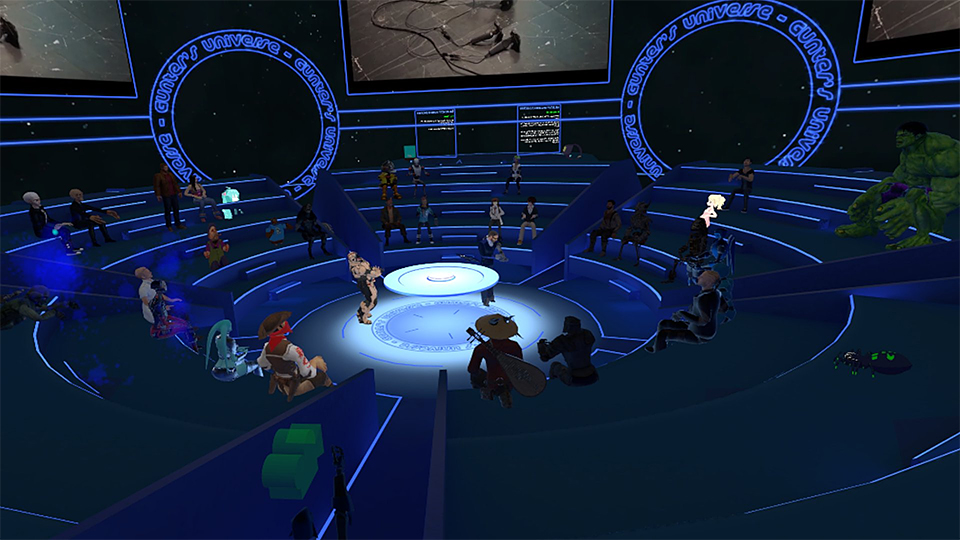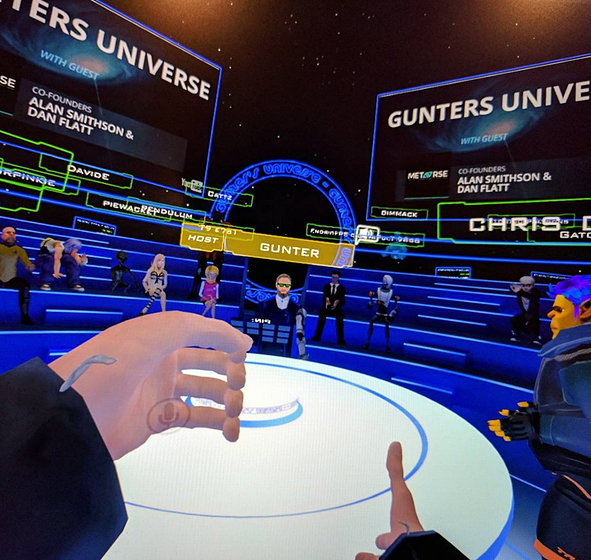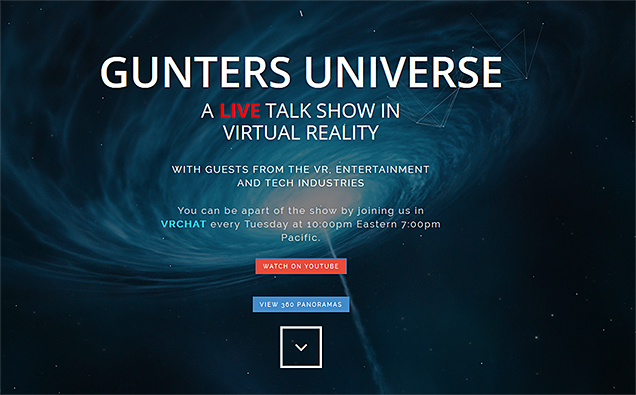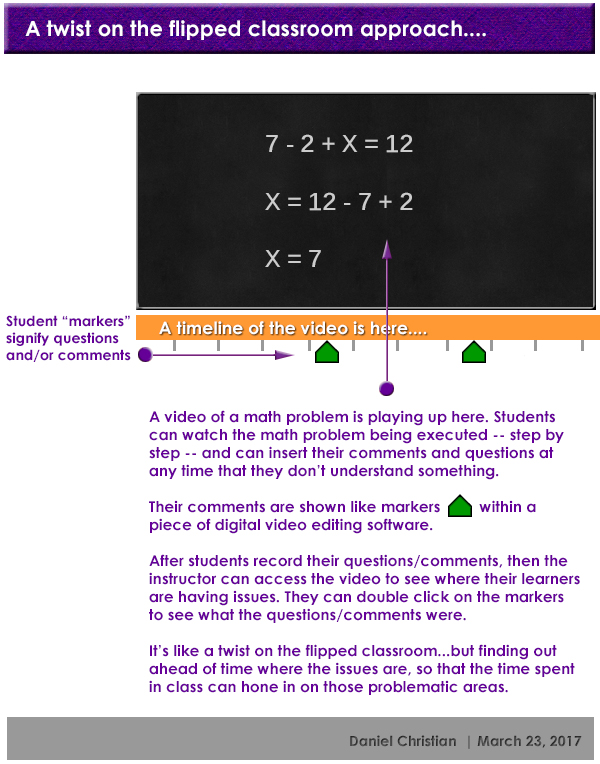From DSC:
A classroom of the future perhaps? These graphics depict VR-based chats/talk shows from @guntersuniverse







From DSC:
A classroom of the future perhaps? These graphics depict VR-based chats/talk shows from @guntersuniverse



The 2017 Dean’s List: EdTech’s 50 Must-Read Higher Ed Blogs — from edtechmagazine.com by Meghan Bogardus Cortez
These administrative all-stars, IT gurus, teachers and community experts understand how the latest technology is changing the nature of education.
Excerpt:
With summer break almost here, we’ve got an idea for how you can use some of your spare time. Take a look at the Dean’s List, our compilation of the must-read blogs that seek to make sense of higher education in today’s digital world.
Follow these education trailblazers for not-to-be-missed analyses of the trends, challenges and opportunities that technology can provide.
If you’d like to check out the Must-Read IT blogs from previous years, view our lists from 2016, 2015, 2014 and 2013.
From DSC:
I would like to thank Tara Buck, Meghan Bogardus Cortez, D. Frank Smith, Meg Conlan, and Jimmy Daly and the rest of the staff at EdTech Magazine for their support of this Learning Ecosystems blog through the years — I really appreciate it.
Thanks all for your encouragement through the years!
From DSC and Adobe — for faculty members and teachers out there:
Do your students an enormous favor by assigning them a digital communications project. Such a project could include images, infographics, illustrations, animations, videos, websites, blogs (with RSS feeds), podcasts, videocasts, mobile apps and more. Such outlets offer powerful means of communicating and demonstrating knowledge of a particular topic.
As Adobe mentions, when you teach your students how to create these types of media projects, you prepare them to be flexible and effective digital communicators. I would also add that these new forms and tools can be highly engaging, while at the same time, they can foster students’ creativity. Building new media literacy skills will pay off big time for your students. It will land them jobs. It will help them communicate to a global audience. Students can build upon these skills to powerfully communicate numerous kinds of messages in the future. They can be their own radio station. They can be their own TV station.
For more information, see this page out at Adobe.com.
From DSC:
This is where we may need more team-based approaches…because one person may not be able to create and grade/assess such assignments.
Teaching math using a school door ?? #edchat pic.twitter.com/7biGT2ntg9
— ?Dan McCabe? (@danieldmccabe) April 28, 2017
New Google Earth has exciting features for teachers — from thejournal.com by Richard Chang
Excerpt:
Google has recently released a brand new version of Google Earth for both Chrome and Android. This new version has come with a slew of nifty features teachers can use for educational purposes with students in class. Following is a quick overview of the most fascinating features…
From DSC:
After seeing the postings below, it made me wonder:
“Today at Apple” bringing new experiences to every Apple Store
Excerpt:
Cupertino, California — Apple today announced plans to launch dozens of new educational sessions next month in all 495 Apple stores ranging in topics from photo and video to music, coding, art and design and more. The hands-on sessions, collectively called “Today at Apple,” will be led by highly-trained team members, and in select cities world-class artists, photographers and musicians, teaching sessions from basics and how-to lessons to professional-level programs.
…
Apple will also offer special programs for families and educators. Teachers can come together for Teacher Tuesday to learn new ways to incorporate technology into their classrooms, or aspiring coders of all ages can learn how to code in Swift, Apple’s programming language for iOS and Mac apps. Families can join weekend Kids Hour sessions ranging from music making to coding with robots. Small business owners can engage with global and local entrepreneurs in the new Business Circuits program.
We’re creating a modern-day town square, where everyone is welcome in a space where the best of Apple comes together to connect with one another, discover a new passion, or take their skill to the next level.
Apple wants kids to hang out at Apple stores — from qz.com by Mike Murphy
Excerpt:
If you’ve just gotten out of school for the day and want to hang out with your friends before you head home, where would you go? In the US, there’s a near-infinite selection of chain restaurants, coffee shops, diners, bookstores, movie theaters, and comic book stores to choose from. But Angela Ahrendts, Apple’s head of retail, wants the answer to be an Apple store.
Apple is in the process of revamping the look and feel of its retail outlets across the world, and to highlight some of the recent changes (including rebranding the “Genius Bar” to the “Genius Grove” and adding foliage everywhere), Ahrendts gave an interview to CBS This Morning, this morning. Ahrendts told CBS that she will see her work as a success when Generation Z, the catchall term for the generation behind the equally amorphous Millennials, decides of their own volition to hang out at Apple stores. As CBS reported…
Lifeliqe Piloting Mixed Reality on Microsoft HoloLens for Grade 6-12 Classrooms — from thejournal.com by Richard Chang
Excerpt:
Using interactive 3D models and lesson plans from its app, Lifeliqe (pronounced “life like”) is now delivering educational content on two major immersive hardware platforms (Microsoft HoloLens and HTC Vive) as well as software platforms (Windows and iOS).
Students and teachers at Renton Prep Christian School in Washington state and Castro Valley Unified College in California participated in the pilot and were the first ever to try out Lifeliqe’s educational content on HoloLens during a science lesson (see video).
“The excitement we witnessed during the pilot shows us the great potential mixed reality has in sparking lightbulb moments.”
Lifeliqe is introducing pilots of mixed reality applications on Microsoft HoloLens — from lifeliqe.com
Excerpt:
Lifeliqe is thrilled to start piloting mixed reality educational scenarios for Microsoft HoloLens in grade 6-12 classrooms! The first two schools we are working with are Renton Prep in Seattle, WA and Castro Valley Unified College, CA. The students and teachers there were the first ever to try out Lifeliqe’s educational content on HoloLens during a Science lesson.
The 82 Hottest EdTech Tools of 2017 According to Education Experts — from tutora.co.uk by Giorgio Cassella
Excerpt:
If you work in education, you’ll know there’s a HUGE array of applications, services, products and tools created to serve a multitude of functions in education.
Tools for teaching and learning, parent-teacher communication apps, lesson planning software, home-tutoring websites, revision blogs, SEN education information, professional development qualifications and more.
There are so many companies creating new products for education, though, that it can be difficult to keep up – especially with the massive volumes of planning and marking teachers have to do, never mind finding the time to actually teach!
So how do you know which ones are the best?
Well, as a team of people passionate about education and learning, we decided to do a bit of research to help you out.
We’ve asked some of the best and brightest in education for their opinions on the hottest EdTech of 2017. These guys are the real deal – experts in education, teaching and new tech from all over the world from England to India, to New York and San Francisco.
They’ve given us a list of 82 amazing, tried and tested tools…
From DSC:
The ones that I mentioned that Giorgio included in his excellent article were:
Perfect marriage between universities and K12 public schools — from huffingtonpost.com by Dr. Rod Berger
Excerpt:
I sat down with Dr. Jeanice Kerr Swift at this year’s AASA conference in New Orleans to learn about the unique advantage of running a public school district that resides alongside one of our nation’s most prominent universities. The University of Michigan provides the district of Ann Arbor with rich partnerships that lift the learning experiences of the children in the community. Kerr Swift is delighted to have the enthusiasm of not only the University but the business community in reaching out to the students of Ann Arbor.
The implementation of real world projects matches University of Michigan scientists with teachers and students to enrich school learning environments. One example is the Woven Wind program that provides real life wind turbine applications. Students learn, and teachers have their classes bolstered by the input of advanced experimentation. Project Lead the Way is another example that is providing modules for classroom learning.
According to Jeanice Kerr Swift, technology should support and strengthen learning, not stand in the place of person-to-person engagement. Devices are there to serve and enhance, not replace teacher-student collaboration and critical thinking. Kerr Swift believes there is a balance of the “Cs” to consider: collaboration, connection, and community. If all the “Cs” are listening and working together, then a school district can thrive.
Jeanice Kerr Swift certainly makes the balance look easy and enviable in Ann Arbor Michigan.


From DSC:
For you ed tech vendors, programmers, and/or entrepreneurs out there, would you please create the software to do this? By the way, for purposes of equal access, this could be done in class — it doesn’t have to be done outside of normal school hours.
At the recent Next Generation Learning Spaces Conference, during one of the workshops, the question was asked:
What skills do your current facilities promote/develop?
A minority of workshop attendees said multidisciplinary collaboration, engagement, and creativity. One university had purposely designed and built a new ecosystem of spaces such that students had different experiences when moving into a variety of setups/rooms. Thus, they viewed this new facility as helping the students adapt to change – which was one of the characteristics and skills they wanted their learning spaces to facilitate in their students.
That said, most of the answers were along the lines of:
Then yesterday, I ran across a tweet from Zeina Chalich (from Sydney, Australia) — and I thought to myself, now THERE’s a great list of skills that our facilities should help develop!
The woman who thinks time has rendered Western education obsolete — from unlimited.world with thanks to Maree Conway for her tweet on this
Excerpt (emphasis DSC):
For years, Finland has loitered in the upper echelons of global literacy and numeracy tables, leading politicians from other Western nations to see its education system as a model of inspiration. Why, then, is the Finnish government submitting it to a radical overhaul?
Dr. Marjo Kyllonen is the Education Manager for Helsinki. Having devised the blueprint for the future of Finland’s school system, she is playing a pivotal role in driving these changes through. She is doing so because she sees the structure and aims of current education systems in the West as increasingly irrelevant and obsolete, relics of an Industrial Age that we started to leave behind a long time ago. She argues that we need to rethink our entire relationship to education to equip future generations with the tools they need to face the challenges to come –challenges such as climate collapse, automated workforces, urbanisation and social division. The key to her blueprint is an emphasis on collaborative, holistic, “phenomenon” teaching – a routine that is less beholden to traditional subject-based learning and instead teaches pupils to work together to deal with problems they will face in their everyday lives, including those they encounter online and in the digital world.
Other:
From DSC:
Whether one agrees with Marjo or not, her assertions are very thought provoking. I really enjoyed reading this piece.
From DSC:
As I was putting together a PowerPoint slideshow for our Teaching & Learning Digital Studio, I figured I might as well make it available for others to see and use as well. So here it is as a PowerPoint slideshow (.ppsx file). Alternatively, if this works better for you on that end, here’s a PDF file of that information.